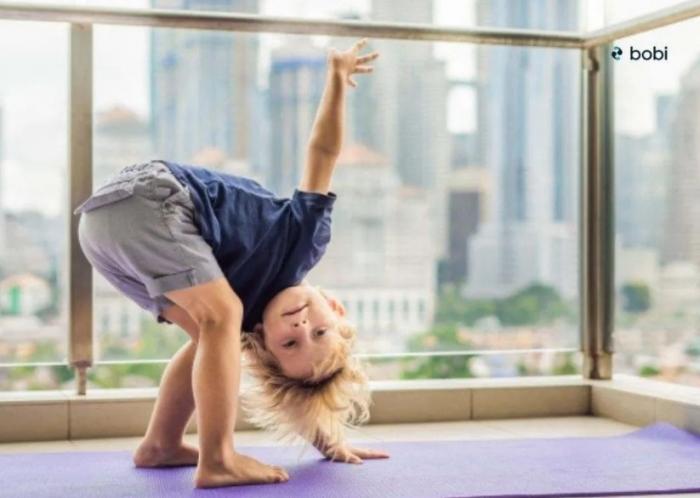Do you ever wonder how you walk perfectly without consciously thinking about your next step or touch your knee even with closed eyes? Some hidden gems (sensory receptors) are working behind such perfect movements of our body received through ‘Proprioceptive Input.’
Proprioceptive input is crucial in our lives as activities like writing, playing piano, and playing sports rely on it. Children with proprioceptive dysfunction cannot handle their day-to-day tasks properly. It’s essential to have a thorough knowledge of the concept to unlock the door to improved bodily awareness and motor skills. Arm your little ones with a secret weapon – bobi, designed to foster a sense of relaxation by regulating breathing patterns.
Read till the end to learn about proprioception, proprioceptive input, its significance, practical proprioceptive activities for children, and much more.
Defining Proprioception
To understand this concept properly, let’s first start with its definition. Proprioception, also known as ‘kinesthesia’ or ‘sixth sense’, is a neuromuscular sense of the body that enables awareness of action, movement, and location without looking consciously. Simply put, it tells your body where it is in the space. Each muscle movement that you do contains proprioception, and its absence requires conscious thinking before taking the next step.
Imagine you’re stuck in a dark room without any light; you’ll walk through the room without looking for each step or colliding with the furniture due to proprioception. All our daily activities depend on this critical internal sense, from an easy handwriting task to more complicated actions like dancing, which requires proprioception.
The Role of Proprioception in Daily Life
Proprioception is of enormous importance in our daily life. It’s crucial to the brain, as it accurately correlates our bodily movements, maintains a balance, and ensures self-regulation and posture. Moreover, it gives a seamless interaction with the environment with the body’s power to focus and speak. The things we do daily, like playing a game or instrument or holding a cup of tea, are proprioceptive input that helps us carry out these actions smoothly and perfectly.
Proprioceptive Input and its Significance
Proprioceptive senses are fundamental for an individual’s development. Sensory receptors in skin, joints, and muscles send proprioceptive input that attaches to the nervous system to control our body movements and position.
Benefits of Proprioceptive Activities
There are two kinds of proprioceptive activities. These may be heavy muscle work activities or activities with deep pressure on the joints and muscles. Jumping, pulling, and pushing weight bearing like a stack of books or a wheelbarrow walk are the activities that fall in the category of heavy muscle activities.
Introducing your children to such activities is a foundational pillar to boost their concentration, motor development, and anxiety management. Deep-pressure activities include hugging your little ones tightly or children hugging a tight ball. With these activities, children get an immediate sense of calm and concentration.
Many of us overlook the importance of these activities. However, Individuals, especially children, feel more secure and “grounded” in their surroundings after getting critical sensory feedback through these activities.
Their benefits aren’t just limited to physical well-being. Instead, you’ll experience an emotional sense of stability with its unique calmness which is critical for overall health.
Identifying Proprioceptive Challenges
Let’s find the answer to the question, ‘What is it like when children have proprioceptive challenges or poor proprioceptive processing? ‘ Although it’s rare, some people, specifically little children, have difficulty processing proprioceptive input. To identify proprioceptive challenges, observe anything indicating a disconnection between an individual’s body and sensory environment. This disconnection might demonstrate clumsiness, difficulty performing delicate motor tasks, and being unmindful of the body’s physical position in the space.
Early identification and mediation are critical to stopping the interference of these challenges in their day-to-day life and learning processes. Therefore, addressing proprioceptive challenges efficiently is recommended to unlock enhanced coordination and bodily awareness.
How to Recognize a Need for Proprioceptive Activities in a Child
If you want to ensure that your child has normal sensory development and a healthy life, proprioceptive activities are essential. You can recognize this need for proprioceptive input through several behaviors that children exhibit, and if addressed at times with specific activities, it can make a difference.
Signs of Proprioceptive Seeking Behavior
Following are some common signs of proprioceptive-seeking behavior:
- Children with proprioceptive dysfunction like to do things that require intense physical force or pressure, like weight-bearing activities. They always hunt for situations to enter into wild play, like swinging on desks, jumping, and bumping against things.
- Another vital sign we often overlook is if your little one loves to give tight hugs or prefers to squeeze into small areas. These signals specify the need for more proprioceptive feedback.
- Holding things with more force than required, like writing with excessive pressure.
- Kicking the feet on the table when sitting at adesk and dragging the feet while walking.
- Children who suffer from proprioceptive challenges love bear hugs and “squishing activities.”
- They like to chew anything they have in their hands, like a pencil or jumper sleeve.
These signs of proprioceptive seeking behavior indicate the child’s effort to satisfy their inborn need for sensory input. It gives them a feeling of security and groundedness.
Signs of Proprioceptive Avoiding Behavior
The signs of Proprioceptive Avoiding Behavior are different from the other ones. Children with this avoidance behavior avoid participating in activities that peers of their age love to do. They refuse to play sports or playground games or perform easy tasks like climbing stairs. They feel uncomfortable getting physically close to others or staying in crowded places, which is a significant but overlooked sign. It indicates the oversensitivity of the avoiders to the proprioceptive input as they find it fearful and agonizing to engage in things that others would discover pleasing or thrilling.
Introduction to Proprioceptive Input Activities
Incorporate proprioceptive input activities into your child’s everyday routine to see its magic in his overall well-being. With these activities, your child will start enjoying things and give their little bodies critical feedback to improve their motor skills, emotional regulation, and awareness.
The Value of Fun Movements
You can bring your child to everyday life by introducing them to valuable, fun movements. These fun and appealing movements include trampoline bouncing, animal walks, and obstacle courses. You can integrate these movements into their playtime, or structured play gives your children their required proprioceptive input in a cheerful way. Such fun activities enhance coordination and body awareness by stimulating the proprioceptive sensors in the muscles and joints. When these activities become a part of a child’s everyday routine, they experience a better improvement in physical abilities and feel joy and a sense of achievement while moving.
The Impact of Oral-Motor Activities
Oral motor activities have a significant impact on those suffering from proprioceptive input challenges. Oral moral activities can prove beneficial if your children always pursue or find an excuse to avoid particular oral sensations. Therefore, encourage your child to chew certain things like specific toys crafted for these purposes or activities like blowing bubbles. These activities will manage your child’s sensory system as it provides feedback to their child – a vital point of proprioceptive input. Moreover, integrating such activities is not just a supporting point for oral development. Instead, it fosters a sense of calmness by boosting emotional regulation and concentration.
The Role of Sports in Providing Proprioceptive Input
Another outstanding way to strengthen your child’s proprioceptive feedback is involving them in sports. So, ensure your children participate in sports like jumping, running, swimming, or ball games. These sports are recommended because they enable the body to accommodate the demands and emerging changes in the surroundings. Your child’s involvement in such sports boosts coordination and physical fitness and develops better social skills and self-esteem with teamwork and accomplishments.
Understanding Heavy Work Activities
Next, include heavy work activities like pulling, pushing, or carrying heavy objects for a sturdy proprioceptive input. For this, we recommend engaging in daily chores like yard work, carrying groceries, and engaging in structured activities to enjoy the benefits. You can build up strength, body awareness, and tolerance, getting a sense of accomplishment. It enables the child to manage their sensory needs efficiently.
Laura Petix, an occupational therapist, discusses the significance of proprioceptive input, commonly referred to as “heavy work,” for sensory regulation.
Practical Proprioceptive Activities for Children
Proprioceptive activities are like a pathway for your child’s healthy development, better sensory processing, and motor skills, resulting in overall happiness. You can choose from a range of activities like outdoor play or rhythm & music to ensure your child’s learning and growth and involve them in fun activities.
Outdoor Play and Recess as Proprioceptive Activities
Outdoors offers many activities that can give your child perfect proprioceptive input. Therefore, encourage your child to swing, use playground apparatus to climb, and slide down a slide. These activities are essential to developing a child’s coordination, muscle strength, and spatial awareness by indulging them in specific challenges. How? Children confronting such natural resistances and diverse surfaces in outdoor play prove a key to sensory development.
The Therapeutic Value of Fine Motor Activities
Another excellent and effective way of proprioceptive input is ‘Fine Motor Activities.’ Introduce your child to fine motor activities like threading beads, molding clay, and using colors to draw. Incorporate these precise but powerful methods in your child’s daily routine for better sensory development. They are an efficient source to strengthen hand-eye coordination and agility as they involve control and preciseness. Doing these activities directly sends light but productive feedback through hands and fingers.
Role of High Energy and Playground Activities in Providing Proprioceptive Input
High-energy activities are for children who use extra force in everything. Jumping, running, participating in team sports, or playing tag are the high-energy activities considered best to feed your child’s craving for extreme proprioceptive feedback. High-energy activities are a perfect solution to burn up their extra energy. Their benefits aren’t limited to this; they satisfy children’s sensory needs by enhancing their concentration and mindfulness.
Resistance Activities and their Effect on Proprioception
Another ideal way for proprioceptive input is your child’s introduction to resistance activities. Tug of war, playing with push-and-pull toys, and using resistance bands are considered resistance activities. These activities build up a child’s joints and muscles, fostering real advantages. When a child gets involved in such heavy tasks, they experience better body awareness with a more grounded impact.
The Connection Between Rhythm/Music and Proprioception
Music is an effective way to soothe your mood and worries. The same goes for proprioception. Introducing your child to activities that fuse music and rhythm, such as dance and playing musical instruments, leaves a unique proprioceptive input. As dancing and playing music requires meticulous movements, your child gets a hold on his coordination and body awareness. It gives your child a sound proprioceptive development but cheerfully and appealingly.
Can Proprioceptive Activities Help with Autism?
Yes, proprioceptive activities prove beneficial for children who have autism. Many people with autism experience sensory processing difficulties that incorporate proprioceptive input. Therefore, when such children get involved in activities like swinging, jumping, and lifting heavy things, they experience better sensory regulation. These activities are crucial in enhancing body awareness, emotional regulation, and motor skills as they send a structured sensory input.
Use these activities as a secret weapon to control sensory processing challenges and foster positive behavior in your little ones.
Proprioceptive Input and bobi
bobi, an innovative relaxation device, is a profound solution for anyone suffering experiencing proprioceptive challenges. An expert psychologist has designed this unique device to regulate breathing patterns and foster relaxation that fits everyone’s needs perfectly. At its heart, it prioritizes gentleness, regulation, and even breathing as an efficient proprioceptive input to transform anxiety into calmness. The structured breathing pattern of bobi resolves an individual’s proprioceptive troubles by providing a tangible and sensory experience. This sensory feedback regulates their sensory stimulation with a grounded sense. So, arm your little ones with this precious tool to address their proprioceptive issues instantly and effectively.
Conclusion
To deal with proprioceptive dysfunction effectively, thorough knowledge of the issue is essential. It allows you to choose a best practice for proprioceptive input to build your child’s ability to overcome challenges and engage with their surroundings like an average child. Encouraging your child to participate in proprioceptive activities is the best way to achieve coordination, balance, and overall health. But, if you want to unlock the profound potential of proprioceptive input, bobi is your key. Its innovative and customizable features allow you to get hold of emotional and behavioral regulation instantly.
FAQs
1. What is proprioceptive seeking behavior?
Proprioceptive seekers like to do intense activities with force and pressure. This behavior includes bumping or crashing into people or things on purpose, giving tight hugs or squeezing into small areas, enjoying rough play, and constantly seeming to be wrestling with siblings or friends. They also tend to touch without permission or stand close to the next person.
2. What are the benefits of proprioceptive input for children?
Proprioceptive input sets up a base scale for different senses in a child. It regulates kids who are over-responsive to sensory inputs and need to calm down and also helps children who are under-responsive and need a little help to engage with the environment. bobi helps regulate proprioceptive inputs with sensory feedback and tangible experience in such cases.
3. How do you teach proprioception?
You can teach proprioception to children through calming activities like breathing, oral activities like gum or foods that need active chewing, and heavy work or exercise activities that require them to use their muscles under high load. Other activities like squeezing a ball are also highly beneficial when introducing children to the concept of proprioception.
Originally published at Meetbobi.com.




























